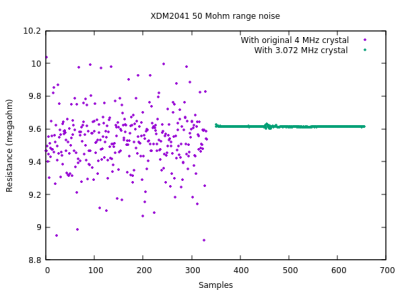After purchasing an Owon XDM2041 bench multimeter for an automated test setup, [Petteri Aimonen] was disappointed to find that at especially the higher mega Ohm ranges, the measured values were jumping around a lot and generally very inaccurate. Since this is an approximately $170 bench multimeter and Owon support wasn’t cooperating, [Petteri] set out to fix the issue, starting with a solid teardown.
 As noted by [Petteri], there’s not a whole lot inside one of these multimeters. The main board with the guts of the whole system contains a GigaDevices GD32F103CBT6 MCU coupled with the star of the show: the HYCON Technology Corporation’s HY3131 multimeter chip. After a peek at the HY3131 datasheet, the culprit was quite apparent: while sampling the presence of mains voltage noise is usually suppressed through the selection of an appropriate crystal.
As noted by [Petteri], there’s not a whole lot inside one of these multimeters. The main board with the guts of the whole system contains a GigaDevices GD32F103CBT6 MCU coupled with the star of the show: the HYCON Technology Corporation’s HY3131 multimeter chip. After a peek at the HY3131 datasheet, the culprit was quite apparent: while sampling the presence of mains voltage noise is usually suppressed through the selection of an appropriate crystal.
Unfortunately, instead of the recommended 4.9152 MHz crystal per the reference schematic for the HY3131, Owon’s engineers had apparently opted for a 4 MHz crystal instead, and so it’s essentially aliasing the line noise.
[Petteri] figured that the resulting sampling timing might work well enough with 60 Hz line frequency, but clearly with 50 Hz there was a lot of noise sneaking into the measurements. After swapping the crystal with a 3.072 MHz one, there was a marked improvement, as the plot shows.















Euclid’s Elements, still relevant 2300 years later with fourier transforms on finite groups.
Good. But this messed up the frequency measurements, since it is based on the CPU clock.
Now someone has to write an open-source firmware that cares of this division factor.
Nice work.
Please continue the development.
HY3131 accepts external clock sources, probably even without changing ENXI. One would probably have to sniff SPI commands to detect applicable modes, but I can see how one could use a fractional-N PLL to get glitch-free transitions between different clock frequencies, perhaps even adding line synchronization that way.
I can confirm that feeding external clock through a 30 pF capacitor works fine, I did just that to try it out before buying the crystal.
Would be nice to see someone implement a hardware solution that fixes both the 50Hz noise problem, and frequency measurement accuracy…
Hmmm I wonder if doing a full calibration would fix the frequency measurement issue.
50Hz line frequency?!?!
Well, there’s your problem. Your power is almost 17% out of spec!
Where are you with such a jankey power grid? Texas?
How can you expect to get anything accomplished under such conditions?
I think you need to move to a more civilized environment.
Canada?
No, but one of the first power transformers I accumulated inthe early seventies was from Hammond (a well known Canadian company), and was rated for 25Hz.
I gather that was the standard put of Niagra for some time.
A 60Hz transformer runs hot on 50 or 25Hz, but the reverse means the transformer doesn’t have to work as hard.
What a needlessly rude comment. Once again, like the metric system, 50 Hz is standard in most of the world except… you guessed it… North America. Maybe read a book before you call everyone else in the world uncivilised.
60Hz: smaller transformer cores need. Might not be an issue for household electronics these days with SMPS, but it matters for large/huge power transformers.
I’m fairly certain that this was a joke on the recent frequency sag and subsequent failure experienced by the Texas power grid.
Don’t feed the trolls.
Almost the entire American continent not just the United States use 60hz, all the way up from Canada, to the US, Mexico, and more than half of South America all use 60hz. Only Argentina and Chile use 50hz. Cuba and Japan both use two standards and they have towns with either and both 50/60 hz lines. (I can only imagine the nightmare for techs.) You can blame induction motors which had to be made fast and cheap, so they standardized 60hz.
Even china has 50Hz, but which chinese developer cares about NOISE?
Hmm, remind me to never buy an Owon product then… 50Hz mains is the standard here. The only places that I know use 60Hz is the USA and some parts of Japan.
I wonder if their little XDM1041 experiences the same issue?
Very probably yes, as the datasheet seems very similar. Nowhere does it clearly tell the sampling rate options available, but it does indicate that 15 ms is the shortest time, same as on XDM2041. I wouldn’t be surprised if they are very similar hardware but they realized the box was unnecessarily large.
Could you not just use a toggle switch to select the crystals?
Owon must know they have noise issues. On AC millivolts range, the display switches to 00.0 as soon as the input crosses to less than 5.0 mv. I wrote to Owon’s technical support contact and they confirmed this is expected behavior. Owon responded by e-mail within a few hours of when I submitted my inquiry.
I made the suggestion to put an UNCAL indicator on the display when the AC input is below 5 mv. This would help for tasks like nulling an amplifier balance where you’re trying to make a signal as small as possible but the exact amplitude reading is not critical.